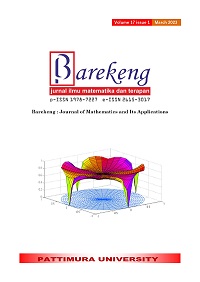LOGISTIC MODELING TO PREDICT THE INTEREST OF THE INDONESIAN PEOPLE FOR BUYING FLOOD IMPACTED INSURANCE PRODUCTS
Abstract
Indonesia is a country located on the equator and in the form of an archipelago. It has a high potential for various types of hydrometeorological-related disasters, such as floods, flash floods, droughts, extreme weather, etc. Almost all cities in Indonesia experience flooding every year, including DKI Jakarta, the capital city of Indonesia. Based on data from the National Disaster Management Agency (BNPB) in 2020, East Jakarta is a city that is prone to flooding. According to BNPB (2013), flooding is a disaster that relatively causes the most losses. Losses caused by floods, especially indirect losses, may rank first or second after an earthquake or tsunami. Floods cause so many losses, and it is necessary to have disaster mitigation efforts to minimize the possibility of flood risks. One risk mitigation due to natural disasters is buying insurance products. However, not everyone buys flood-impact insurance products due to economic and social factors. This study aims to create a model with the Logistics Regression Model to determine the factors influencing Indonesian people's interest in purchasing flood-impact insurance products. The research data is from 140 households in East Jakarta, Indonesia, using a non-probability purposive sampling technique. Furthermore, with a significance level of 10%, the logistic regression model obtained 14 significant regression coefficients. In the end, the obtained model is evaluated based on its level of accuracy. The results showed that the accuracy rate was almost excellent, namely 89.3%.
Downloads
References
BNPB RI, “Rencana Nasional Penanggulangan Bencana 2015-2019,” 2014. [Online]. Available: https://www.bnpb.go.id//uploads/renas/1/BUKU RENAS PB.pdf.
BNPB RI, “Buku Saku Tanggap Tangkas Tangguh Menghadapi Bencana,” 2017. [Online]. Available: https://siaga.bnpb.go.id/hkb/po-content/uploads/documents/Buku_Saku-10Jan18_FA.pdf.
S. Dahlia, N. H. Tricahyono, and W. F. Rosyidin, “Analisis Kerawanan Banjir Mengunakan Pendekatan Geomorfologi di DKI Jakarta,” J. Alami J. Teknol. Reduksi Risiko Bencana, vol. 2, no. 1, pp. 1–8, 2018.
E. Y. Gunawibawa and H. Oktiani, “Politik & Bencana Banjir Jakarta 2020: Analisis Peta Percapakan #JakartaBanjir,” Expo. J. Ilmu Komun., vol. 3, no. 1, pp. 60–75, 2020, doi: https://doi.org/10.33021/exp.v3i1.989.
A. Rosyidie, “Banjir: Fakta dan Dampaknya, serta Pengaruh dari Perubahan Guna Lahan,” J. Reg. City Plan., vol. 24, no. 3, pp. 241–249, 2013, doi: https://doi.org/10.5614/jpwk.2013.24.3.1.
P. Sidi, Pemanfaatan Ilmu Aktuaria dalam Mewujudkan Jaminan Risiko Banjir di dalam Konsep Smart City. Universitas Terbuka (UT), 2017.
A. Findayani, “Kesiap Siagaan Masyarakat dalam Penanggulangan Banjir di Kota Semarang,” J. Geogr. Media Inf. Pengemb. dan Profesi Kegeografian, vol. 2, no. 1, pp. 102–114, 2015, doi: https://doi.org/10.15294/jg.v12i1.8019.
Y. Hikmah, V. Yuristamanda, I. R. Hikmah, and K. A. Safitri, “Probit Modeling of Indonesian Economic and Social Factors to the Interest in Purchasing Flood-Impacted Insurance Products,” Int. J. Ind. Eng. Prod. Res., vol. 33, no. 2, pp. 1–12, 2022, doi: 10.22068/ijiepr.33.2.13.
Sugiyono, Memahami Penelitian Kualitatif. Bandung: Alfabeta, 2014.
BNPB RI, “Hujan Lebat Sebabkan 23 Kecamatan DKI Jakarta Terdampak Banjir,” 2020. https://bnpb.go.id/berita/hujan-lebat-sebabkan-23-kecamatan-dki-jakarta-terdampak-banjir (accessed Jun. 01, 2020).
K. Nisa, “Rekapitulasi Data Banjir DKI Jakarta dan Penanggulangannya Tahun 2020,” 2020. https://statistik.jakarta.go.id/rekapitulasi-data-banjir-dki-jakarta-dan-penanggulangannya-tahun-2020/ (accessed Jun. 01, 2020).
CNN Indonesia, “BNPB Sebut Banjir Rendam 23 Kecamatan di DKI, Jaktim Terparah,” Feb. 08, 2020. https://www.cnnindonesia.com/nasional/20200208215738-20-472935/bnpb-sebut-banjir-rendam-23-kecamatan-di-dki-jaktim-terparah (accessed Jun. 01, 2020).
I. Komara, “Warga di 10 Lokasi Jakarta Timur Dievakuasi dari Banjir,” detikNews, Jan. 01, 2020. https://news.detik.com/berita/d-4842307/warga-di-10-lokasi-jakarta-timur-dievakuasi-dari-banjir (accessed Jun. 01, 2020).
Kumparan News, “Titik Banjir Jakarta Bertambah, Berikut Daftar 46 RW yang Terendam,” 2020. https://kumparan.com/kumparannews/titik-banjir-jakarta-bertambah-berikut-daftar-46-rw-yang-terendam-1ssTJoGx9Qv/3 (accessed Jun. 01, 2020).
N. P. Putra, “Cek Titik Banjir di Ruas Jalan Jakarta Timur,” Liputan6, 2020. https://www.liputan6.com/news/read/4186976/cek-titik-banjir-di-ruas-jalan-jakarta-timur (accessed Jun. 01, 2020).
Syahraeni, “Analisis Tingkat Pemahaman Mahasiswa Jurusan Ilmu Perpustakaan Fakultas Adab dan Humaniora UIN Alauddin Makassar terhadap Sistem Klasifikas DDC,” UIN Alauddin Makassar, 2016.
Sugiyono, Metode Penelitian Kuantitatif Kualitatif dan R&D. Bandung: Alfabeta, 2018.
D. L. Olson and D. Wu, Predictive Data Mining Models, 2nd ed. Singapore: Springer, 2020.
H. Zhou, Learn Data Mining Through Excel: A Step-by-Step Approach for Understanding Machine Learning Methods. USA: Apress, 2020.
D. Hosmer Jr, S. Lemeshow, and R. Sturdivant, Applied Logistic Regression, 3rd ed. New York: John Wiley & Sons, 2013.
M. Hasnain, M. F. Pasha, I. Ghani, M. Imran, M. Y. Alzahrani, and R. Budiarto, “Evaluating Trust Prediction and Confusion Matrix Measures for Web Services Ranking,” IEEE Access, vol. 8, pp. 90847–90861, 2020, doi: 10.1109/ACCESS.2020.2994222.
M. Stojanoviü et al., “Understanding Sensitivity, Specificity, and Preductive Values,” Vojnosanit. Pregl., vol. 71, no. 11, pp. 1062–1065, 2014.
Copyright (c) 2023 Yulial Hikmah

This work is licensed under a Creative Commons Attribution-ShareAlike 4.0 International License.
Authors who publish with this Journal agree to the following terms:
- Author retain copyright and grant the journal right of first publication with the work simultaneously licensed under a creative commons attribution license that allow others to share the work within an acknowledgement of the work’s authorship and initial publication of this journal.
- Authors are able to enter into separate, additional contractual arrangement for the non-exclusive distribution of the journal’s published version of the work (e.g. acknowledgement of its initial publication in this journal).
- Authors are permitted and encouraged to post their work online (e.g. in institutional repositories or on their websites) prior to and during the submission process, as it can lead to productive exchanges, as well as earlier and greater citation of published works.






1.gif)



